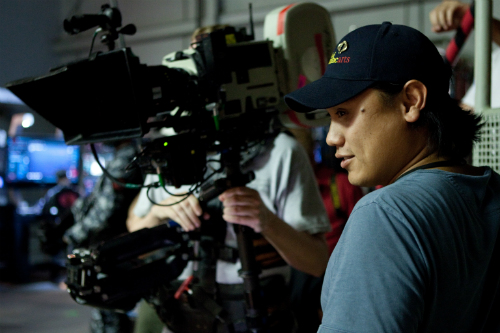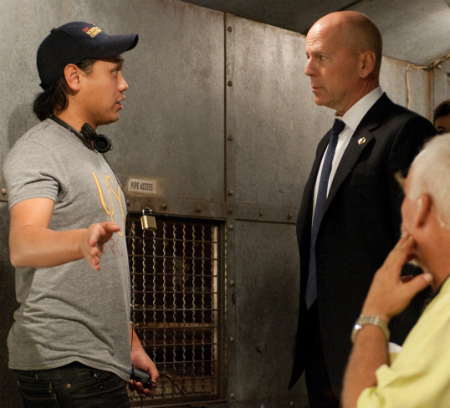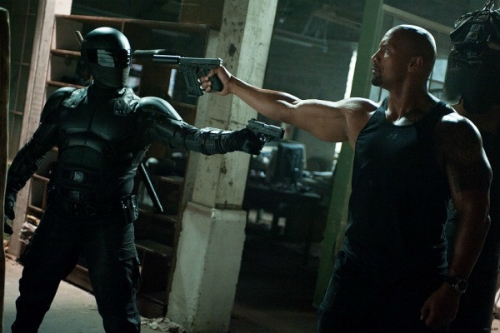TR Interview: Jon M. Chu Talks G.I. Joe: Retaliation…and Masters of the Universe!
 |
| Jaimie Trueblood |
The director of two Step Up sequels and a Justin Bieber documentary might not seem the most obvious choice for a G.I. Joe film, but like a performer with fancy footwork, John M. Chu has successfully managed to do the delicate dance of pleasing both the studio and the fanbase with Retaliation. It seems obvious in hindsight to hire a director who was actually a fan of the toys, but maybe it had to take three decades in order for the original ’80s Real American Hero-era kids to grow up.
We did some group interviews earlier with Chu and others, but I also got to talk to the director 1:1, and finally snag some hints about his big-screen plans for He-Man.
Luke Y. Thompson: Thank you for making a faithful G.I. Joe movie. We’ve been waiting for that for quite a while!
Jon M. Chu: Thank you, thank you! We’ve got more to do. This is just the start of it, and hopefully we can play more with it.
LYT: So you’re signed on to do a couple more if this one does well, which it almost certainly will?
JMC: I’m not signed on for any more, and we don’t have necessarily a plan for another one, but there’s so much in the G.I. Joe world that we couldn’t do it all, and that’s one of the hardest things of doing the movie. I wanted to do it all, but you can only fit so much in a movie, and we were already crammed full with characters and things that we could do. If the fans love it and they want to come out again, I would be honored to, but we don’t have any plans, as of yet.
LYT: Do you feel like you had something to prove on this? I remember when you were announced, everyone was like “Oh, no, not the Justin Bieber guy! How dare he do an action movie!”
JMC: (laughs) I don’t know if I ever need something to prove in making movies. I love the process of making movies and I love making films. I definitely wanted to make my 10 year old self proud, for sure! I wanted to make all the guys and girls who grew up on G.I. Joe – especially in the 80’s with the comic book and the cartoon and the toys – to really feel like we got a movie that represented what we loved, and what we believed was real when we were playing with our toys in the back yard, getting them all dirty and having week-long epic adventures. I definitely felt the pressure of making sure that we all felt that there’s a movie that represents that in its best form.
 |
LYT: What role in the process did you have as far as choosing the new characters, and saying “OK, I’m not going to continue with most of the characters from the first film, but here are the ones I do want.” Was that choice made for you, or did you have a role in that?
JMC: Partly, and partly not. When I came on, there was already a script, so Reese and Wernick had already set out a lot of the characters. Firefly, Roadblock was in there – Roadblock wasn’t as prominent, so it was a little bit later when that journey of a side character sort of becoming sort of a main character was something we pursued. Joe Colton we got to add, which was really fun, which was a new idea when I came on. So to me, partly I got in, but they had been working on the script previously.
LYT: I remember when I was a kid, the Destro figure was always the coolest because he had the metal face. Is it a bummer that he’s so expensive to do that he’s not really practical to have in a lot of screen time?
JMC: We wanted to do him, we could have done more with Destro, but the problem was we definitely wanted to do Firefly. Destro had such a huge role in the other one, not Destro-as-Destro, but in different form, and it was just too much. I wanted to start to create how Cobra Commander would be, and we had Zartan and Storm Shadow, so we were going to have so many characters to serve, it would have been a disservice to what we could do with Destro to just throw him into the group and then not be able to serve it, so hopefully we’ll do more, and we would have fun with it. I think there is a vast amount of story that you could do with him, but for this one, it was just too crammed.
It was a struggle to decide if we would acknowledge – we’re doing a sequel, but at the same time it’s sort of a re-attitude of the thing. How much can you acknowledge, or should you acknowledge of the last movie, because there’ll be confused audience members who don’t know who Destro is, who are coming into this for the first time, and you throw a guy with a silver face in there, and refer to him, or do you just ignore him and pretend you’re not even interested in it yet – we were constantly struggling with those questions throughout the film, actually.
LYT: So what does it feel like to basically play with toys on such a large scale?
JMC: (laughs) It’s the best job in the world! I mean, literally, we’re there – and it’s not just the toys, but you get Dwayne and Bruce playing those toys? You never, ever get your dream cast, and the fact that those first names that we wrote on a piece of paper when we first looked at the script and we first sat down, and they actually made it to the movie was pretty amazing! My head was going to explode many, many times throughout the shooting of the movie.
LYT: The big cliffside battle, which is pretty obviously the highlight of the movie – do you feel commonalities between doing that and doing a big dance number in a Step Up?
JMC: That one in particular was not a lot like that. I think some of the instincts help, but there are so many pieces to that, that it wasn’t like we would go shoot in two weeks then edit it all together. It was like, we’re shooting in the mountains of Vancouver, guys on ziplines; then we’re shooting on a green screen – giant, giant green screens where they’re swinging; then we’re creating set pieces with rocks they’re acting on. It was many, many pieces coming together over months and months, so that was a big challenge, but something that ultimately came together. Nine minutes of no dialogue: we didn’t know if it was going to work until it was all finished together.
 |
LYT: One of the positive changes that people noted on a very small scale was eliminating the lips on Snake Eyes’ mask. Who made that call?
JMC: I think we all sort of made that call from the very beginning, coming in. The first thing we got into in terms of design was, hey guys, we knew we had to do that, we knew we had to jump in and figure out – you know, Snake Eyes has been reinvented so many times, the way we would do it would define a lot of the attitude of the movie, the tone of the movie, and so we did, I would say, 50 different versions of Snake Eyes, at least. Even just his visor, and what color it would be, or how much opacity there would be, or what kind of texture, or how shiny would it be. We wanted Snake Eyes to feel like there was a real human being underneath there, and that that face was real armor, not just a creature of some sort, so that people would understand, at least just a little more.
LYT: Is it hard when you’re telling a story and creating jeopardy and things like that, to have a character who is so invincible, who almost has no weaknesses?
JMC: (laughs) Yeah, and that’s a lot of our characters! Roadblock, and Joe Colton, and Snake Eyes, and all these guys – they have certain gifts, and certain expectations for how you want them to be, yet for a movie you want to have them be vulnerable, you need to have – that’s why starting the movie with the Joes getting wiped out was critical to us, to set the tone that nobody’s safe, anything can happen and that the danger was real. I actually think the only way you can go so far with the ninjas, the only way you can go so far with Cobra, is that you know the danger at least to them is real. So that was an important part of being able to pull of the fun that we wanted to be able to pull off in the movie.
LYT: In terms of the continuity of G.I. Joe, were you more of a fan of the cartoon, or the Marvel comic book, or just the storylines that came on the packages?
JMC: The toys I played with, probably even more than I watched the cartoon, although I watched the cartoon all the time – it was the toys where I would really create my own adventures with it, and the packages obviously had a big influence in that. It wasn’t until later that I got more into the comic books, and I felt like the comic book was the tone of how I played with the toys. So when we were doing the movie, we really wanted to bring that idea with it, because the comic book had that…not sophistication, but a little bit of that that made them human beings, that made them have flaws, that made them – the struggles just between Snake Eyes and Scarlett, the love story to that, to me was epic, and so beautiful and operatic. So we wanted to create an environment where a story like that could be possible.
LYT: Are you still attached to Masters of the Universe?
JMC: Yeah. We’re still in the beginning stages, designing a ton, and this is sort of the most fun phase, because we get to do a bunch of different designs of the world, and the costumes, and make a lot of mistakes, as much as we can, so we know where we shouldn’t go, and where we should be headed, in terms of the tone and the look of the movie.
LYT: I know you probably can’t tell us a lot about He-Man, but can you give us any indication if the tone will be closer to Filmation, or closer to the mini-comics, or closer to the bios on the current toys? Are you going for a campier tone like the cartoons, or something slightly more serious, do you think?
JMC: We’re going for slightly more serious, and I wouldn’t say “serious” as a dark tone you don’t necessarily want He-Man to be in, but it’s not campy. We’re not going campy. It’s sort of an origin story of how He-Man came to be, and to me that gives you a lot of opportunity to create real culture in this world. What is Eternia really like, what are the cultures, what are the languages they’re speaking, what are Snake Men, what are Beast Men, what are all these things, and how do they exist in this world? So we’re taking a real look at creating life on this planet, on this world, that hopefully will translate. And again, we’re in a very early designing phase of it, the script is great, but we’re still very early at figuring out exactly how theatrical we go, and how real we go, and how dark we can take it.
LYT: Do you think same actor for He-Man and Prince Adam, or different actors?
JMC: It’s a little too early to tell. We’re playing with the technique of how we’ll actually pull that off.
